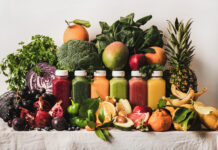
Article sponsored by the United Soybean Board
In the U.S., 83% of consumers recently surveyed think the pandemic has permanently changed the way they live[1]. One thing that isn’t likely to change, though, is the demand for plant-based food and beverages for home meals that we saw during the surges of COVID-19. Plant-based dairy and meat are predicted to continue their growth through 2024, driven by Millennials and Gen Z consumers[2].
Bright spots for soy
With the rising costs of food, the use of soybean oil in foodservice has many benefits to both restaurants and consumers. Both conventional and high oleic soybean oil can be used for everything from baking and sautéing, to salad dressings and deep fat frying. Soybean oil has the added advantages of its neutral flavor and high smoke point (450°F)[3] compared with many other cooking oils.
Mindful eating supported by soy
Soyfoods continue to keep pace with changing health-related priorities. Among the year’s food trends is mindful eating, a concept that encompasses ingredient sourcing, environmental considerations, clean eating, plant-based diets, and health considerations.
Approximately 24% of participants in a U.S. consumer survey reported that they consider digestive health to be the most important aspect of their overall health; about one-third said they actively try to consume probiotics[4]. Traditional fermented soyfoods such as miso and tempeh, as well as soy yogurt, contain probiotics that can help with overall gut health, posing soy as a great protein option.
Versatility with soyfoods
Soyfoods offer a convenient way for consumers to incorporate more plant-based ingredients into recipes, with a range of product choices that can be adapted to vegan, vegetarian, and flexitarian or hybrid eating styles. The current social media climate supports these food attitudes, with 63% of conversations about vegan and vegetarian options being positive[5].
While many plant proteins are promoted as meat and dairy alternatives, soyfoods have a long history and a place of prominence in Asian cuisines. Traditional soyfoods include tempeh in Indonesian cuisine to tofu in Japanese cooking. Product options today allow consumers to enjoy soyfoods across the menu. Choices include soy beverages, packaged soy protein snacks like flavored soy nuts, as well as versatile edamame pasta and indulgent frozen soy-based desserts.
Given that global food prices reached an all-time high in March 2022[6], the affordability of many soy products, including tofu, is advantageous as well. In a recent 10-country survey of consumers, around half of the flexitarian respondents said that supermarkets and restaurants don’t offer enough plant-based product choices, and they considered the available ones to be generally too expensive[7].
However, one calculation estimates that price parity between plant-based meat and conventional meat may happen sooner rather than later, with prices for plant-based products achieving parity to conventional ones in 2023[8].
Soy speaks to sustainability
Soyfoods made with sustainably-grown U.S. Soy combine with animal proteins in ways that hold appeal for vegetarians, flexitarians, and omnivores alike. Soy complements dairy products and can be paired with meats, like roasted pork with edamame. Textured soy protein (TSP) can be combined with ground beef or ground turkey for chili and pasta sauces, or mixed with honey to top fruit crumble desserts.
Choosing high-quality U.S. Soy also helps to meet the United Nations 17 Sustainable Development Goals (SDGs), with the environmentally responsible U.S. Soy Sustainability Assurance Protocol (SSAP), promoting overall well-being for global consumers.
Overall, U.S. Soy has many benefits in the eyes of the consumer, and for helping to counteract rising food costs in restaurants. If you’d like to learn more, visit ussoy.org to learn more on how soy can be integrated across menus.
Sources
- Datassential FoodBytes: “The Pandemic: Two Years and Counting,” Datassential Trend Report, Trendspotting, Volume 99, April 8, 2022.
- NPD Group. “Gen Zs and Millennials Will Drive Growth of Plant-Based Foods in the U.S. Over the Next Few Years.” Press Release, October 13, 2021. (https://www.npd.com/news/press-releases/2021/gen-zs-and-millennials-will-drive-growth-of-plant-based-foods-in-the-u-s-over-next-few-years/)
- https://www.healthline.com/nutrition/soybean-oil#1.-High-smoke-point
- InMar Intelligence, 2022 Spring Trends. PG-Inamr-2022SpringTrendsGuide.pdf
- Food and Agriculture Organization of the United Nations, “FAO Food Price Index makes a giant leap to another all-time high in March,” April 8, 2022. https://www.fao.org/worldfoodsituation/foodpricesindex/en/
- Innova Market Insights. “Choice and Price Key to Continued Boom in Plant-Based Foods.” Press Release, November 8, 2021. https://www.innovamarketinsights.com/press-release/choice-and-price-key-to-continued-boom-in-plant-based-foods/
- The Good Food Institute: “When will the price be right? Pathways to alternative protein affordability.” January 19, 2022. https://gfi.org/blog/when-will-the-price-be-right/








